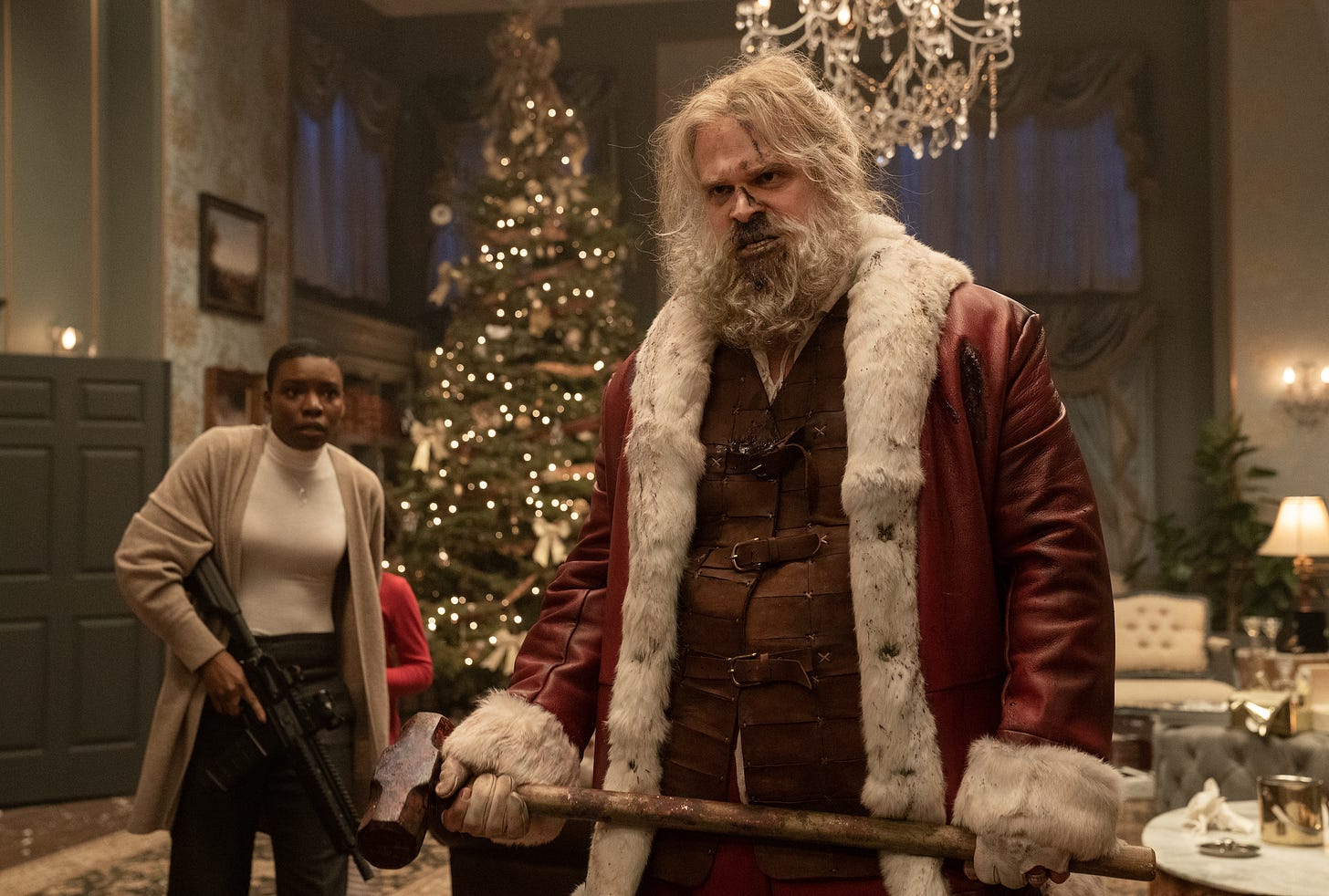In Review: 'All the Beauty and Bloodshed' and 'Violent Night'
The latest from Laura Poitras examines a career of art and activism. Elsewhere David Harbour takes some bad guys on a Christmas slay ride.
All the Beauty and the Bloodshed
Dir. Laura Poitras
122 min.
When we first meet photographer and activist Nan Goldin in Laura Poitras’ astonishing documentary All the Beauty and the Bloodshed, she and fellow activists from a group called P.A.I.N. are huddling together outside the Metropolitan Museum of Art, preparing for a demonstration in March of 2018. Their target is The Sackler Wing, so bequeathed by the Sackler family, whose name was connected to its philanthropic contributions to the art world before it was connected to Purdue Pharma, Oxycontin, and the opioid crisis that followed. Befitting her legacy as an artist, the demonstration had a strong conceptual component, too: Hundreds of empty pill bottles were getting dumped into the reflecting pool at the Temple of Dendur exhibit, symbolizing the lives lost to Oxy prescriptions. They then stage a “die-in” on the museum floor.
If you’ve seen How to Survive a Plague—or simply remember the activist movement sparked by the AIDS crisis in the ‘80s—you might feel a twinge of recognition here. That combination of creative, audacious demonstrations and die-ins, along with aggressive lobbying within the system itself, was a hallmark of ACT UP, and P.A.I.N. is working from that effective playbook. Later in the film, it’s revealed that Goldin was present for ACT UP. She was present in the mid-‘70s gay idyll of Provincetown, Massachusetts, where she hung out with John Waters and his troupe, and forged a special friendship with Cookie Mueller. She was present as curator for an AIDS exhibit in 1989 that was so controversial that the NEA pulled support and Alphonse D’Amato tore up the catalog on the Senate floor.
To watch All the Beauty and the Bloodshed is to witness a half-century of art and activism in New York City, and Goldin isn’t a Zelig or Forrest Gump figure either: She was not merely present, but central. Yet Poitras’ documentary isn’t about burnishing her reputation, but deepening our understanding of who she is and the personal heartaches and passion that inform her work. The danger of profiling an artist of her stature is that the stories might seem chewed-over and Wiki-fied, the biographical grist of dozens of profiles. But Poitras gains a level of intimacy with Goldin that makes the film feel like a true collaboration, with the director giving her subject the space to tell her story in full.
Structured in six chapters, the film cleanly interweaves the chronology of Goldin’s life with her current efforts to hold the Sackler family accountable for an epidemic that nearly took her life. It seems like a conventional bit of organization, but Poitras has planted an emotional time bomb that tick-tick-ticks its way to a devastating conclusion. She starts with Goldin’s childhood as the youngest of two daughters, born to parents who didn’t seem to want a suburban family lifestyle, but imposed it on their children anyway. Her sister’s rebellion inspired Goldin as much as her eventual suicide haunted her, and she found photography to be a natural outlet for expression her understanding of the truth.
Goldin shares incredible stories about her early years in New York, where she logged time as a bartender at Tin Pan Alley in Times Square, found a place for herself in the underground of modern artists and radical leftists, and eventually barreled into gallery spaces with her candid, unvarnished photos. Her friends throughout this period including a who’s-who of gay artists, many decimated by the AIDs epidemic, and these personal losses affirmed her work with and about the marginalized.
There are elements of standard context-setting here, like talking-head interviews with Patrick Radden Keefe, the New Yorker writer who authored Empire of Pain, the definitive account of the Sackler family. But Poitras works in slideshow-style exhibits from various stages in Goldin’s career to reflect and deepen her personal recollections, and she gets a burst of urgency from P.A.I.N.’s efforts to remove the Sacklers from the art world—first shutting down their money, then going after their name. Her presence in the permanent galleries of these museums gives her voice a special amplification.
The source of the title is best discovered when it surfaces late in the film, but All the Beauty and the Bloodshed encapsulates the love and tragedy that has affected Goldin’s life without coarsening it. Her perseverance and perspective are often startling to watch, like a scene where gives a virtual witness statement in the Sackler case that’s honest yet politically savvy, shifting attention to gaping holes in the justice system. She has spent a lifetime absorbing those losses and a lifetime making sure they matter. — Scott Tobias
All the Beauty and the Bloodshed is currently played at IFC Center in New York. It opens in Los Angeles and San Francisco tomorrow, and will continue to expand through December and beyond.
Violent Night
Dir. Tommy Wirkola
112 min.
Santa (David Harbour) is just going through the motions. Nursing a beer (then another and another) in an English pub as Violent Night opens, he complains to another drinker—a fellow in a Santa costume who assumes his new acquaintance is also dressing the part and not the real thing—about how kids today are just greedy and only ask for video games and how whatever magic he used to feel on the job has vanished. Then, to the astonishment of the pub’s barmaid, Santa vanishes after accidentally, she believes, heading to the roof instead of out the front door. She’s overwhelmed by the majesty of a flying sleigh up to the moment Santa barfs all over her from on high.
If nothing else, Violent Night knows how to set the table. In the process, it also sounds a warning: if you’re not in the mood for crassness and grossness (the barf being the first of many bodily fluids to make an appearance), maybe check out some other Christmas movie. But those who stick around should know they’ve pretty much seen the one note Violent Night will keep hitting at a louder volume from beginning to end. You don’t expect to see Santa barf/piss/swear/smash skulls with a sledgehammer, but here he is doing just that after getting drawn into a hostage situation in which a group of would-be thieves — led by a Christmas-hating mastermind with the codename “Mr. Scrooge” (John Leguizamo) — have targeted a family of New England billionaires. Can you believe it?
It helps that Harbour makes for an extremely game vengeful Santa, digging down to find layers of grumpiness and bloodlust unseen on Stranger Things. (Kris Kickass?) But only up to a point. Apart from an acidic performance from Beverly D’Angelo and a few clever moments like a sequence in which Trudy (Leah Brady), the young hostage who ultimately helps reignite Santa’s Christmas spirit, unleashes a string of bloody, Home Alone-inspired booby traps on her captors, the film mostly offers uninspired variations on familiar action beats. It’s a fine line between paying homage to Die Hard and playing like one of the many Die Hard imitators that appeared in that film’s wake, and Violent Night doesn’t always know how to walk it. Does it make a difference that it’s Santa delivering the death blows and profane quips? Only if the Christmas season has you feeling extremely generous. —Keith Phipps
Violent Night opens tonight nationwide.









The art that came out of the AIDS Crisis is some of the most powerful work I've ever witnessed, and All the Beauty and the Bloodshed puts that to really really effective use despite some typical activist doc trappings and style. Was truly shocked at how much of it functions as a memoir of Queer History, which imo makes it absolutely necessary.
Violent Night sounds more like a wait till HBO thing but All The Beauty and the Bloodshed sounds amazing and makes me think of how Poitras is really the only person from Citizenfour who still seems to have stuck to their guns and beliefs while Snowden became a Russian puppet and Bitcoin guy and Greenwald became Peter Thiel’s plaything